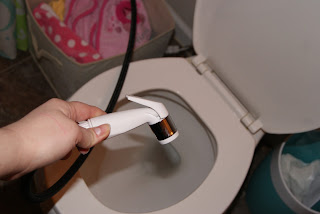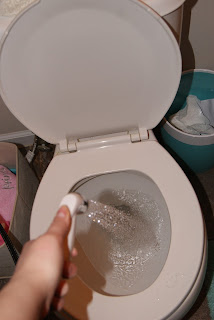To tell you all how we switched to cloth diapers involves telling you guys how Maisy became a bottle baby. When you're pregnant, all you do is plan for the next 18 years of your life with your little one. I know I did.
I spent nine months of my life planning how long I was going to breastfeed (6 months minimum), when we would start solids (5 months), when we would start potty training (18 months). No one ever ever ever suggested that my schedule would fall apart at the seams.
But it did, life happens. Here we go.
When Maisy went in for her two month checkup in February, she was only 5 ounces more than her birth weight. Our doctor told us that other than her weight, she was a happy, healthy baby girl. She was just not getting enough to eat. We had no idea because she simply thought the little amount she was fed was all she got, and she was okay with that.
(She is clearly her father's child.)
A few visits with doctors and late night phone calls to a lactation consultant later, I came to accept that I simply could not produce enough to sustain my baby, and Maisy became primarily formula fed.
Since the two month fiasco, in three weeks, Maisy has gained almost 4 pounds. She is now a happy, chubby 10 pounder, and I couldn't be prouder.
The problem with formula feeding, frankly, is cost. There is formula and formula water to buy, bottles to invest in. Breast feeding is free, formula feeding is pricey.
It was for our saving's sake that Justin and I made the decision to switch to cloth diapers.
It started as an experiment. We were browsing through Target (easily the best place on earth) and saw an endcap in the baby section full of Charlie Banana cloth diapers. We bought one to test it out and we were hooked.
These are no longer your Momma's cloth diapers. Let me go over the facts.
- Diapers like Charlie Banana's come in a one-size-fits-all with adjustable elastic and snaps. This means when you buy a diaper, your child can realistically wear and re-wear it until they are potty trained. Think about all the diapers you wont have to buy after your initial investment.
- The types of cloth diapers Justin and I use are called All-In-2's (AI2). These diapers consist of a shell and an insert. Inserts come in a variety of materials from microfiber to organic wool, even hemp. When the diaper is wet, you change the insert, not the entire diaper. This means that if your child goes all day without a BM you will only use one diaper shell a day. Let me say that again to settle in, ONE DIAPER A DAY. Some AI2's require you to stuff the diaper shell with an insert, some simply snap in and out of place. Easy as pie.
- Research has shown that cloth diapered babies potty train faster. Why? Because they can feel the difference between wet and dry. Cloth diapers are absorbent, yes, but not like disposable diapers that draw wetness completely away.
- Cloth diapers are ADORABLE. Look at this sweet little bubble butt. How could you not love this? I never have to worry about keeping track of all the fancy diaper covers that come with all MJ's dresses. The diapers take care of that for me!
- Cloth diapers do require a little bit more care. I wash Maisy's diapers three times a week. I could easily limit this to once or twice a week if we invested in more inserts, but we chose not to so I do more laundry. Realistically though, doing three extra loads of laundry a week is the equivalent the same amount of water a toilet will flush when Maisy is potty trained. Honestly. We did the math. 1 year of 3 extra loads of laundry water per week = 1 year of extra flushed toilets.
- Feeling the green house gasses closing in on you every time you throw away a trash bag full of disposable diapers? Cloth diapers have NO WASTE.
If you decide the move to cloth diapers is for you, I recommend getting between 6-12 diapers with at least two inserts for each diaper (if you go with AI2s).
I also recommend you invest in a diaper sprayer. To keep the cloth diapers from staining, you will want to dispose of all diaper solids in the toilet. You can buy fancy brand-name sprayers that attach to your toilet for $50. OR you can do what we did and go to Lowes and spend $20. Throw a pair of rubber gloves in there and you're looking at $25 to not scrape your baby's #2 into the toilet with your bare hands.
That's a standard replacement kitchen sink sprayer with some specific hoses. I could try and tell you exactly what we go but I would embarrass myself. Head over to Lowes, tell them what you need and the plumbing experts will guide you around like a puppy on a leash.
Spraying it all away? So worth $25 dollars.
A diaper sprayer sprays cold water directly from the toilet and you can easily flush all the waste down the tank. The cold water keeps stains from settling, and keeps diapers fresh. I even use it to pretreat baby stained laundry.
When you wash cloth diapers, use an all natural detergent with no added brighteners, scents, or colors. We are dealing with the mot sensitive areas of our most sensitive family members. I use Trader Joes Cleanliness Is Next To Godliness but here is a good comparison of other detergents.
The best way to decide if cloth diapering is a move for you, is to talk to a cloth diaper Momma. I asked my friend Claire (have you seen her photography yet?) for advice and she served me up a big old plate of knowledge.
Advice from an experienced Momma makes all the difference. But don't be afraid to experiment yourself. Every baby (and Momma) is different!
Thanks for looking!







